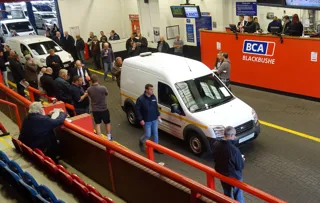Christmas is just a few days away, but for several weeks now its impact has been felt in the used light commercial vehicle (LCV) market, Dean Bowkett reports.
As I write, the battle of the festive adverts is reaching its pitch and the shops are full of people buying presents they are not sure about for people who may (or may not) like them.
But it’s not just the shops that are busy. The internet is cranked up with online shoppers whose frenzied clicking has meant an invasion force of LCVs is required across the country to deliver gifts to their doors.
As the year draws to a close the need to meet the delivery requirements of both the online shoppers and those buying items too big for them to transport themselves puts added pressure on firms to ensure they have sufficient reliable vans of the right size and quality to hand.
Andy Picton, Glass’s chief commercial vehicle editor, notes that the traditional medium panel van in its various guises remains the most popular choice among LCV buyers due to its practicality.
He also pointed out that three of the top five selling new LCVs by volume (year-to-date) are Fords. In order, the Transit Custom, Transit, Mercedes-Benz Sprinter and Volkswagen Transporter took the top four places followed by Transit Connect in September’s new van sales.
Every month does seem to be a repeat of the previous one in the used van market with prices rising, volumes on the increase and conversion rates high.
Glass’s saw sales volumes rise an impressive 8.7% for September year-on-year.
READ MORE: Remarketing: Christmas cheer and it’s not even Halloween yet
The car-derived sector is seeing significant volumes of Volkswagen Caddy Maxi and Ford Transit Connects and the high degree of specification, particularly on the former, is ensuring they are flowing through the auctions with relative ease.
Medium panel vans have always performed strongly in new LCV sales terms so it will not come as a surprise to see they also made up around a third of vans going through the auctions.
Overall small and medium vans were around 70% of all used sales in September according to Glass’s, with demand coming from small-to-medium enterprises (SMEs) and the self-employed.
For much of the UK, winter is little more than a colder, wetter version of summer with ice and snow not really an issue. I hope I haven’t spoken too soon.
But that observation hasn’t stopped the usual seasonal uplift in demand for 4x4s.
Glass’s noted 24-48-month-old double cab pick-ups and vans doing particularly well as long as they were the right specification, condition and colour – a comment well worth noting as it applies across all used LCVs.
Conversion rates are still showing little sign of deterioration with Picton reporting first time conversions running at almost 82% in September. That is a 4% increase over the previous month and 2% up on September 2016.
Part of the reason for the high levels of conversion is undoubtedly the volume of demand. Manheim head of LCV Matthew Davock is reporting a 16% year-on-year increase in attendance at its physical auctions and a 19% rise in online attendance.
The increase in bidders has seen conversion rates improve by 12% over October 2016 to 78% for the month with Manheim reporting two vendors achieving 100% conversion rates.
The speed of the move to online remarketing and buying should not be underestimated.
Davock said Manheim had “now seen 100% year-on-year growth in online-only auction events”.
"When combined with its Simulcast auctions Manheim is now seeing 86% of LCV sales attracting online bids with “38% of all vans sold to an online bidder”.
It is not just how you sell, but what you sell, which remains important and having the right specification remains key to getting a quick turnover of vehicles with base and/or low horsepower models continuing to struggle.
According to Glass’s’ the most sought-after features are air conditioning, metallic paint and automatic gearboxes.
Shoreham Vehicle Auctions (SVA) LCV sales manager Tim Spencer also reported condition as being an important factor, citing a recent utility company auction of four- to six-year-old vans which were “in good condition and with full service histories” adding that even those with high mileages were getting “strong bids” due to the condition and documentation.
READ MORE: Remarketing: Retail and construction sectors boosting demand for LCVs
Spencer added that such is the demand for LCVs in the right condition “some investment in valeting and preparation prior to going under the hammer” is a lesson worth learning.
He also noted that buyers are very happy to bid on ex-rental stock up to 36 months old if they are from the “blue chip rental suppliers” and are in good condition with provenance.
This adds weight to the fact that ex-rental vehicles from a reliable source are actually a good buy.
Davock noted that the LCVs going through the halls were four months younger than a year ago, averaging 59 months, and with around 3,000 fewer miles on the clock.
This provides further evidence that we are seeing the tail end of the unwinding of the vans kept for longer and run for higher mileages during the austerity period.
With conversion rates so strong it is unsurprising to see prices are also continuing to move upwards.
September saw average prices rise by 2.6% over the same period last year and 1.8% over the previous month according to Glass’s.
It also noted that some vans, such as Doblo, Kangoo and Combo, remain popular and “regularly sell to guide”.
That’s an interesting statement which raises the age-old question of whether the guide reflects the market or does the market reflect the guide?
Manheim has also been regularly reporting month-on- month price rises with Davock reporting October’s sales performance as “staggering”.
According to Manheim, October saw a “18% year-on-year increase in average van sale values” which outperformed what it had already considered to be an incredible September.
Even with average damage increasing by 26% to £870 per van, Manheim still reported an average sales price of £5,749 which is £172 more than October 2016.
Vans in the £4,500-£6,500 price range were singled out by Davock as having performed particularly well in October.
READ MORE: Remarketing: Poll results help auctions buck usual summer trends
While we usually see an uplift in defleeted vans towards the end of the year as buyers opt for new vehicles, there is currently little evidence of this happening to any great extent.
Manheim commented that the trend it noted in September has continued into October with the volume of van de-fleets continuing to soften, reducing by 4% compared with the previous month.
This could mean a potential influx of vans at the end of the year and into January, but the general opinion seems to be that this is unlikely.
Large panel vans of the right quality, mileage and specification remain in short supply.
Glass’s reported shortages on Mercedes-Benz Sprinters which has pushed up its prices at a faster rate than the already buoyant market growth.
The inability for supply to meet demand was also the message from SVA who believe the supply of four- to five-year-old fleet stock will be insufficient to satisfy demand which means prices should remain strong into the New Year.
While Manheim was a little more cautious with its forecast for the remainder of the year, the first 10 months have seen “incredible” results and, like SVA, it also believes this will continue to be the case through into 2018 with LCV sales volumes and pricing remaining strong and demand staying ahead of supply.
That sounds like as good a reason as any to raise a glass of mulled wine to 2017 – provided you are not driving, of course.




















Login to comment
Comments
No comments have been made yet.